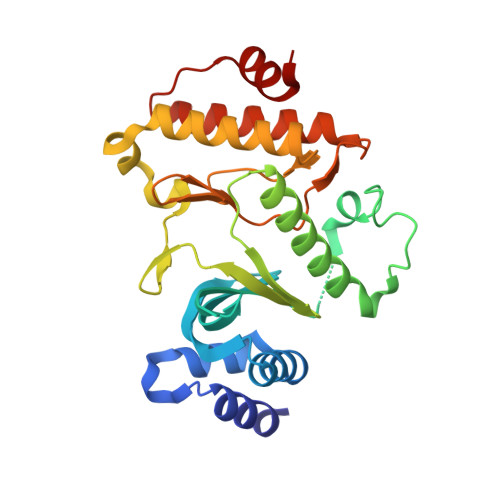Interaction of rio1 kinase with toyocamycin reveals a conformational switch that controls oligomeric state and catalytic activity.
Kiburu, I.N., Laronde-Leblanc, N.(2012) PLoS One 7: e37371-e37371
- PubMed: 22629386
- DOI: https://doi.org/10.1371/journal.pone.0037371
- Primary Citation of Related Structures:
3RE4 - PubMed Abstract:
Rio1 kinase is an essential ribosome-processing factor required for proper maturation of 40 S ribosomal subunit. Although its structure is known, several questions regarding its functional remain to be addressed. We report that both Archaeoglobus fulgidus and human Rio1 bind more tightly to an adenosine analog, toyocamycin, than to ATP. Toyocamycin has antibiotic, antiviral and cytotoxic properties, and is known to inhibit ribosome biogenesis, specifically the maturation of 40 S. We determined the X-ray crystal structure of toyocamycin bound to Rio1 at 2.0 Å and demonstrated that toyocamycin binds in the ATP binding pocket of the protein. Despite this, measured steady state kinetics were inconsistent with strict competitive inhibition by toyocamycin. In analyzing this interaction, we discovered that Rio1 is capable of accessing multiple distinct oligomeric states and that toyocamycin may inhibit Rio1 by stabilizing a less catalytically active oligomer. We also present evidence of substrate inhibition by high concentrations of ATP for both archaeal and human Rio1. Oligomeric state studies show both proteins access a higher order oligomeric state in the presence of ATP. The study revealed that autophosphorylation by Rio1 reduces oligomer formation and promotes monomerization, resulting in the most active species. Taken together, these results suggest the activity of Rio1 may be modulated by regulating its oligomerization properties in a conserved mechanism, identifies the first ribosome processing target of toyocamycin and presents the first small molecule inhibitor of Rio1 kinase activity.
- Department of Chemistry and Biochemistry, Center for Biomolecular Structure and Organization, University of Maryland, College Park, Maryland, United States of America.
Organizational Affiliation:

















